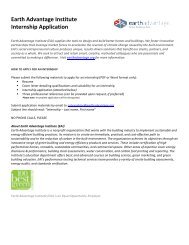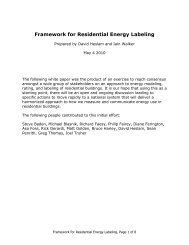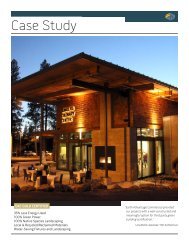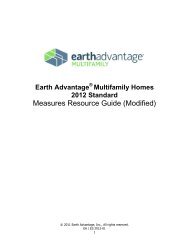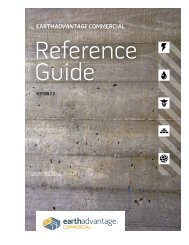EA New Homes Measures Guide - Earth Advantage
EA New Homes Measures Guide - Earth Advantage
EA New Homes Measures Guide - Earth Advantage
Create successful ePaper yourself
Turn your PDF publications into a flip-book with our unique Google optimized e-Paper software.
2012 <strong>Earth</strong> <strong>Advantage</strong> Residential<br />
<strong>Measures</strong> Resource <strong>Guide</strong><br />
1.2.8<br />
Accountability Form: General Energy Health Land Materials Water<br />
Preserve Natural Features<br />
0 0 1 0 1<br />
Description: The protected area must be identified with construction fencing, flagging, silt fence or a similar method.<br />
Benefit: Clearing, grading, and preparing land for construction can damage natural features that add character and value to property. This<br />
can have serious effects on hydrologic and habitat functions. For this reason, it is vital to protect sensitive areas from direct encroachment.<br />
Such areas provide an essential cover, feeding, nesting, and breeding habitat for many species of fish and wildlife. They also slow the path<br />
of water allowing it to percolate through the soil recharging groundwater supplies. Protecting sensitive areas is environmentally<br />
responsible, and in most cases it is required by law. Sensitive features include streams, lowlands (areas with small streams and associated<br />
wetlands), wetlands, shorelines, rock outcroppings and bluffs.<br />
Verification: Builder will identify the area on the site plan. <strong>EA</strong> Rater will visually identify protected areas and the fencing or flagging that<br />
identifies it.<br />
1.2.9<br />
Protect Non-Grading Areas<br />
Accountability Form: General<br />
Energy<br />
Health<br />
Materials<br />
Water<br />
0 0 2 0 1<br />
Description: Protect non-graded areas of lot from ground disturbance by equipment, vehicles, and material staging as well as topsoil<br />
removal. The protected area should be at least 30% of the lot and must be identified with construction fencing, flagging, or a similar<br />
method. The disturbed area should not extend past 20 feet of home's foot print.<br />
Land<br />
Benefit: An essential characteristic of healthy soil is air space within the soil structure. These soil pores transport air, water, and allow plant<br />
roots to grow more easily. Equipment on a jobsite compacts the soils, lessening their ability to absorb rainwater. Damage to existing root<br />
structures can occur if equipment and vehicles move too close to trees.<br />
Verification: <strong>EA</strong> Rater will visually identify protected areas and see that fencing or flagging is installed.<br />
1.2.10<br />
Pervious Surface (25%-50% / >51%)<br />
Accountability Form: General<br />
Energy<br />
Materials<br />
Water<br />
0 0 0 0 1/2<br />
Description: Replace impervious surfaces, such as asphalt or concrete, with pervious materials that allow rainfall to percolate into the soil<br />
on the site. Points are awarded based on the percentage of the hardscape that is pervious. Hardscape includes driveways, walks, patios,<br />
etc. Pervious surfaces include pervious concrete, porous asphalt, permeable interlocking concrete pavers, vegetated or gravel-filled plastic<br />
grids, and porous gravel surfaces. Rock layers beneath the surface must be properly sized to hold typical storm events. Spaces between<br />
pavers (if used) must be filled with rock, not sand, so that underlying material remains pervious. In poorly draining soils, it is suggested the<br />
builder consult with a geotechnical engineer. Overflow or perforated pipes may be required in poor soils. No fine-grained materials should<br />
be stored on or adjacent to a pervious paved area, nor should they be used where they can wash onto a pervious surface. Examples of<br />
such materials include bark dust, compost, topsoil, and other material stockpiles. Pervious materials should be installed after the<br />
remainder of the site is stabilized to avoid clogging during construction.<br />
Health<br />
Land<br />
Benefit: Groundwater is replenished by rainwater that soaks into the ground. Covering the ground with impermeable materials interrupts<br />
the natural recharging of ground water. One way to reduce this impact is to replace impervious surfaces, such as driveways, sidewalks,<br />
roofs, and patios with pervious surfaces that allow the surface water to percolate into the ground on site. Replacing impervious areas with<br />
pervious surfaces reduces the potential for flooding, both on and off-site, by allowing more water to soak directly into the ground.<br />
Verification: <strong>EA</strong> Rater will identify the pervious surfaces and visually estimate the amount of the hardscape that qualifies. If available,<br />
landscape or site plans can assist. On-site verification at final inspection.<br />
1.3 Building Design<br />
Page 6 of 70



